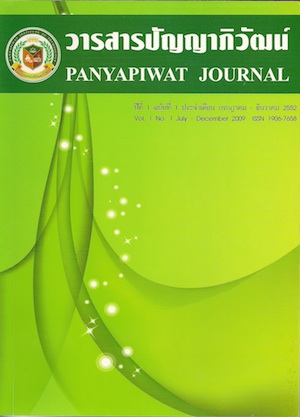นวัตกรรมองค์การในวิสาหกิจขนาดกลางและขนาดย่อม บนพื้นฐานแนวคิดองค์การแห่งการเรียนรู้
Main Article Content
Abstract
บทคัดย่อ
แนวคิดองค์การแห่งการเรียนรู้เป็นแนวคิดที่มีความสำคัญเป็นอย่างยิ่งต่อการพัฒนานวัตกรรมองค์การของวิสาหกิจขนาดกลางและขนาดย่อม โดยเฉพาะอย่างยิ่งในสภาพแวดล้อมทางเศรษฐกิจปัจจุบันที่มีการเปลี่ยนแปลงอย่างรวดเร็วตลอดเวลา ซึ่งการพัฒนานวัตกรรมองค์การอย่างต่อเนื่องนั้นก็เพื่อมุ่งตอบสนองความต้องการของกลุ่มตลาดเฉพาะที่วิสาหกิจขนาดใหญ่ไม่สามารถจะตอบสนองได้เพียงพอ โดยที่แนวคิดองค์การแห่งการเรียนรู้จะส่งเสริมการพัฒนานวัตกรรมองค์การเป็นอย่างมากในการสนับสนุนให้สมาชิกในองค์การมีทักษะในการเรียนรู้และสามารถนำความรู้พื้นฐานที่มีอยู่มาประยุกต์ใช้ให้เกิดนวัตกรรมใหม่อันจะเป็นประโยชน์ต่อองค์การอย่างเป็นรูปธรรม
คำสำคัญ : องค์การแห่งการเรียนรู้, นวัตกรรมองค์การ, วิสาหกิจขนาดกลางและขนาดย่อม
Abstract
The concept of Learning Organization is extremely important for the development of Organizational Innovation of Small and Medium Enterprises (SMEs) especially, in under current dynamic of economic situation. To continually develop the Organizational Innovation is to respond to the niche markets which, large enterprises are not able to support perfectly. In details, the concept of Learning Organization significantly supports the development of Organizational Innovation by encouraging organization members to apply their knowledges in order to facilitate innovation which, will generate benefit to an organization concretely.
Keywords : Learning organization, Organizational Innovation, Small and Medium Enterprises (SMEs)
Article Details
I and co-author(s) certify that articles of this proposal had not yet been published and is not in the process of publication in journals or other published sources. I and co-author accept the rules of the manuscript consideration. Both agree that the editors have the right to consider and make recommendations to the appropriate source. With this rights offering articles that have been published to Panyapiwat Institute of Management. If there is a claim of copyright infringement on the part of the text or graphics that appear in the article. I and co-author(s) agree on sole responsibility.
References
แก้วตา โรหิตรัตนะ. (2549), TQM กับความสําเร็จของวิสาหกิจขนาดย่อม. ธุรกิจกับผลิตภาพ กรุงเทพ: สํานักพิมพ์
มหาวิทยาลัยธรรมศาสตร์
โกศล ดีศีลธรรม. (2550) ผลิตภาพ ปัจจัยพัฒนาสูการแข่งขันยุคใหม. กรุงเทพ: นำอักษรการพิมพ์
ทิพวรรณ หล่อสุวรรณรัตน์. (2548), องค์การแห่งความรู้: จากแนวคิดสู่การปฏิบัติ, กรุงเทพ บริษัท แซทโฟร์ พรินติ้ง จํากัด
วรภัทร์ ภูเจริญ. (2537), องค์การแห่งการเรียนรู้และการบริหารความรู้, กรุงเทพ: พิมพ์ที่ บริษัท อริยชน จํากัด
ศุภกิจ ศรีกาญจนา. (2549). การเพิ่มผลิตภาพของวิสาหกิจขนาดกลางและขนาดยอม. ธุรกิจกับผลิตภาพ. กรุงเทพ: สํานักพิมพ์
มหาวิทยาลัยธรรมศาสตร์ สถาบันเพิ่มผลผลิตแห่งชาติ (เรียบเรียงโดย สุกัญญาติรวุฒิพร), (2545), Smart People Smart
Work. กรุงเทพ: ห้างหุ้นส่วนจํากัด ซีโน ดีไซน์ สุรชัย ภัทรบรรเจิด. (2008), ปัจจัยสู่ความสําเร็จของผู้ประกอบการ SMEs. โครงการศึกษา วิเคราะห์และเตือนภัย SMEs รายสาขา สํานัก งานส่งเสริมวิสาหกิจขนาดกลางและขนาดย่อม (สสว.), Website: http://cms.sme.go.th/cms/c/portal/layout?p_L_id=22.280
สํานักส่งเสริมวิสาหกิจขนาดกลางและขนาดยอม.(2551). รายงานสถานการณวิสาหกิจขนาด กลางและขนาดย่อม ปี 2550 และแนวโน้ม ปี 2551. ปทุมธานี: บริษัท ทางสะดวก (ประเทศไทย) จํากัด
วรภัทร์ ภู่เจริญ. (2537), องค์การแห่งการเรียนรู้และการบริหารความรู้ กรุงเทพ: บริษัทอริยชน จำกัด.
Agmon, T., & Drobnick, R. (1994). Small Firmsin Global Competition. New York: Oxford University Press, Inc.
Alegre, J., & Chiva, R. (2007). Learning to Innovate. Gaining From Organizational Learning Capability. working paper.retrieved from ABI/INFORM Global database.
Baumback, C. (1988) How to Organize and Operate a Small Business. USA: Prentice-Hall International, Inc.
Bhaskaran, S. (2006). Incremental Innovation and Business Performance: Small and Medium-Size Food Enterprises in a Concentrated Industry Environment.Journal of Small Business Management.
Casey, D. (1996). Managing Learning Organizations. PA: Open University Press.
Dai, Z., & Duserick, F. (2008). An Empirical Study of Learning-Enabled Innovation.Competition Forum. retrieved from ABI/INFORM Global database.
Degraff, J. & Quinn, S.E. (2007). Leading Innovation. How to jump start your organization growth engine. USA: McGraw-Hill Companies, Inc.
Dibrell, C., Davis, P. S and Craig, J. (2008).Fueling Innovation through Information Technology in SMEs. Journal of Small Business Management.
Drucker, P.F. (1985). The Innovator and Entrepreneur. New York: Harper & Row Publishers
Drucker, P.F. (2003). The Discipline of Innovation in Harvard Business Review on The Innovative Enterprise. MA: Harvard Business School Publishing.
Ebers, M. (1997). The Formation of Inter-Organizational Networks. Oxford: Oxford University Press.
Garvin, D. (1998). Building a Learning Organization. Harvard Business Review on Knowledge Management.
Gee, E. A., & Chaplin T. (1979). Managing Innovation. USA: John Wiley & Sons, Inc.George, M. L.,& James W. and Kimberly W.(2005). Fast Innovation: Achieving Superior Differentiation, Speed to Market,and Increased Profitability. New York: The McGraw-Hill Companies.
Goffin, K.,& Mitchell, R. (2005). Innovation Management: Strategy and Implementation Using the Pentathlon Framework.New York: Palgrave Mcmillan.
Hargreaves, P.,& Jarvis, P. (1998). The Human Resource Development Handbook.London: Clays Ltd.
Hatten, T. (2009). Small Business Management. NA: Houghton Mifflin Company.
Jones, O., & Tilley, F. (2003). Competitive Advantage in Smes: Towards A Conceptual Framework in Tilley, Fiona ,Jane Tonge (ed)Competitive Advantage in Smes. WestSussex: John Wiley & Sons Ltd.
Ismail, M. (2005). Creative climate and learning organization factors: their contribution towards innovation. Leader-ship & Organization Development Journal.
Kalling, T. (2007). The lure of simplicity:learning perspectives on innovation.European Journal of Innovation Management Vol. 10 No. 1. retrieved from ABI/INFORMGlobal database.
Keskin, H. (2006). Market orientation,learning orientation, and innovation capabilities in SMEs An extended model.European Journal of Innovation Management Vol. 9 No. 4. retrieved from ABI/INFORMGlobal database.Mumford, A. (1995). The learning organization in review. Industrial and Commercial Training. Vol. 27. MCB UP Ltd. retrieved from ABI/INFORM Global database.
Ogawa, E. (1994). Small Business Management Today. Asian Productivity Organization.
Porter, M.E. (1990). The Competitive Advantage of Nations. New York: The FreePress.
Rampley-Sturgeon, N. (2006). Small Business Big Profit: How to increase the profitability of your entrepreneurial business.Great Britain: Pearson Prentice Hall Business.
Robbins, S. P., & Coulter, M. (แปลโดยวิรัช สงวนวงศ์วาน), (2546), การจัดการและพฤติกรรม องค์การ, บริษัท เพียร์สัน เอ็ดดูเคชั่น อินโด ไชน่า จํากัด, กรุงเทพ: พิมพ์ที่ บริษัท เอช เอ็น กรุป จํากัด
Robbins, S. P. (1990). Organization Theory:Structure Design and Applications. NewJersey: Prentice-Hall, INC.
Simpson, B. (2002). The knowledge needs of innovating organizations. Singapore Management Review. retrieved from ABI/INFORM Global database.
Smith, M. K. (2001). “The learning organization”, the encyclopedia of informal education. Website: http://www.infed.org/biblio/learning-organization.htm.
Smith, M. K. (2001). “Peter Senge and the learning organization”, the encyclopedia of Informal education. Website: http://www.infed.org/thinkers/senge.htm Accessed19/11/05
Smith, P. R. (1997). Processes Facilitating Reliance on Trust in Inter-Organizational Networks in Ebers, Mark. The Formationof Inter-Organizational Networks. Oxford:Oxford University Press
Steinhoff D., & Burgess, J. F. (1989). Small Business Management Fundamentals.USA: McGraw-Hill Book Company.
Sullivan, D. O. & Dooley, L. (2009). Applying Innovation. USA: SAGE Publications Inc.
Takeuchi, H. & Nonaka, I. (2004). Hitotsubashion Knowledge Management. ClementiLoop. Singapore: John Wiley & Sons (Asia).
Tangen, Stefan. (2003). An Overview of Frequently used Performance Measures.Work Study Vol. 52 No. 7. retrieved from ABI/INFORM Global database.
Urabe, K., Child, J., & Kagono, T. (1988).Innovation and Management: International Comparisons. The concept of Fit in Contingency Theory. Berlin: Walter de Gruyter & Co.
Westover, R. (2006). Learning Organizations:A Preliminary Investigation between the Presence of a Learning Organization and Profit. A Thesis for the degree of master of arts in communication and leadership studies: Gonzaga University.
Wick, C., & Leon, L. (1993). The Learning Edge:How Smart Managers and Smart Companies Stay Ahead. USA: Mcgraw Hill,Inc.


